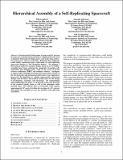Hierarchical assembly of a self-replicating spacecraft
Author(s)
Langford, William Kai; Ghassaei, Amanda Paige; Jenett, Benjamin Eric; Gershenfeld, Neil A
DownloadAccepted version (1.831Mb)
Open Access Policy
Open Access Policy
Creative Commons Attribution-Noncommercial-Share Alike
Terms of use
Metadata
Show full item recordAbstract
© 2017 IEEE. Extraterrestrial fabrication of spacecraft by current best-practice manufacturing methods is complicated by the need to integrate thousands of unique parts, each made using a diversity of processes and raw materials. Reducing this complexity could enable exponential space exploration via self-replicating spacecraft (known as Von Neumann probes). We propose a hierarchical model for machine design, based on 13 reversibly-assembled part types, reducing the complexity of machine self-replication and bridging prior work in the areas of in-situ resource utilization (ISRU) and modular robotics. Analogous to amino acids in biological systems, these parts form a basis set for the electronic and mechanical subsystems of an exploratory spacecraft. In simulation we validate representative subsystem designs and develop a hierarchical architecture for the design of mechanisms, actuation, and electronics. By standardizing and modularizing the parts, we drastically reduce the diversity of the required supply chain as well as the minimum viable payload mass. We estimate that a seed launch could contain approximately 105 parts, fit within the envelope of a 3U cubesat, and enable the assembly of over one hundred self-replicating assemblers.
Date issued
2017-03Department
Massachusetts Institute of Technology. Center for Bits and AtomsPublisher
IEEE
Citation
Langford, Will, Ghassaei, Amanda, Jenett, Ben and Gershenfeld, Neil. 2017. "Hierarchical assembly of a self-replicating spacecraft."
Version: Author's final manuscript